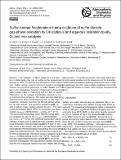Sulfur isotope fractionation during oxidation of sulfur dioxide: gas-phase oxidation by OH radicals and aqueous oxidation by H2O2, O3 and iron catalysis
Author(s)
Harris, E.; Sinha, B.; Hoppe, Peter; Crowley, J. N.; Ono, Shuhei; Foley, S.; ... Show more Show less
DownloadHarris-2012-Sulfur isotope fract.pdf (3.430Mb)
PUBLISHER_CC
Publisher with Creative Commons License
Creative Commons Attribution
Terms of use
Metadata
Show full item recordAbstract
The oxidation of SO[subscript 2] to sulfate is a key reaction in determining the role of sulfate in the environment through its effect on aerosol size distribution and composition. Sulfur isotope analysis has been used to investigate sources and chemical processes of sulfur dioxide and sulfate in the atmosphere, however interpretation of measured sulfur isotope ratios is challenging due to a lack of reliable information on the isotopic fractionation involved in major transformation pathways. This paper presents laboratory measurements of the fractionation factors for the major atmospheric oxidation reactions for SO2: Gas-phase oxidation by OH radicals, and aqueous oxidation by H[subscript 2]O[subscript 2], O[subscript 3] and a radical chain reaction initiated by iron. The measured fractionation factor for [superscript 34]S/[superscript 32]S during the gas-phase reaction is α[subscript OH] = (1.0089±0.0007)−((4±5)×10[subscript −5]) T(°C). The measured fractionation factor for [superscript 34]S/[superscript 32]S during aqueous oxidation by H[subscript 2]O[subscript 2] or O[subscript 3] is α[subscript aq] = (1.0167±0.0019)−((8.7±3.5) ×10[superscript −5])T(°C). The observed fractionation during oxidation by H2O2 and O3 appeared to be controlled primarily by protonation and acid-base equilibria of S(IV) in solution, which is the reason that there is no significant difference between the fractionation produced by the two oxidants within the experimental error. The isotopic fractionation factor from a radical chain reaction in solution catalysed by iron is αFe = (0.9894±0.0043) at 19 °C for [superscript 34]S/[superscript 32]S. Fractionation was mass-dependent with regards to 33S/32S for all the reactions investigated. The radical chain reaction mechanism was the only measured reaction that had a faster rate for the light isotopes. The results presented in this study will be particularly useful to determine the importance of the transition metal-catalysed oxidation pathway compared to other oxidation pathways, but other main oxidation pathways can not be distinguished based on stable sulfur isotope measurements alone.
Date issued
2012-01Department
Massachusetts Institute of Technology. Department of Earth, Atmospheric, and Planetary SciencesJournal
Atmospheric Chemistry and Physics
Publisher
Copernicus GmbH
Citation
Harris, E. et al. “Sulfur Isotope Fractionation During Oxidation of Sulfur Dioxide: Gas-phase Oxidation by OH Radicals and Aqueous Oxidation by H2O2, O3 and Iron Catalysis.” Atmospheric Chemistry and Physics 12.1 (2012): 407–423.
Version: Final published version
ISSN
1680-7324
1680-7316